Many people believe that working on your chest muscles means hitting the gym constantly and using equipment at all times. However, there are plenty of chest exercises you can perform without any additional equipment. When creating a solid chest workout routine, you can simply rely on your own body weight.
Case in point, some of the best chest workouts are exercises that don’t require equipment, like regular push-ups, decline push-ups, incline push-ups, off-set push-ups, one-leg push-ups, diamond push-ups, plyometric push-ups, wide push-ups, seal push-ups, and deficit push-ups.
Let’s go through all of them, one by one.
Best Chest Workout Without Equipment
Here are our favorite chest exercises that don’t require equipment:
- Regular push-ups
- Decline push-ups
- Incline push-ups
- Off-set push-ups
- One-leg push-ups
- Diamond push-ups
- Plyometric push-ups
- Wide push-ups
- Seal push-ups
- Deficit push-ups
All the exercises that we’ve chosen to share today are push-up variations, which is no coincidence. We wanted to focus on exercises that would provide a similar effect as exercises that require gym equipment, and data suggests that push-ups produce comparable levels of muscle activation and offer similar strength gains as the bench press.
One research group in Japan compared hypertrophy outcomes between the bench press and push-ups in 18 young men who had been resistance training for at least 1 year prior. The findings were that there were no significant differences between the bench press and the push-up groups — all the subjects experienced improvements in hypertrophy. [1] Another study comparing 4 weeks of doing either push-ups or bench presses three times a week showed similar improvements in both 1RM bench press strength and chest hypertrophy. [2]
1) Regular Push-ups

Media type: GIF
Media Content: Someone doing a regular push-up
Movement Category: Primary
Programming: 6 to 12 reps per set at 2 to 3 reps short of failure, e.g. RPE 7 to 8.
Weight: Bodyweight
The good-old classic push-up. This exercise is as popular as it is because a) it’s easy to understand; b) it engages multiple muscle groups, such as your pecs, triceps, anterior deltoids, and core muscles; and, c) it’s a very straightforward way to boost your overall strength.
Push-up instructions:
- Take a quadruped (table-top) position. Place your hands directly below your shoulders, your knees below your hips. Tuck your toes under. Your arms should be straight, and your head in a neutral position facing the floor.
- Straighten out one leg at a time, lifting the knees off the floor, into a plank.
- Once you’re in a plank position, retract the shoulder blades and unlock your elbows to slowly lower your body towards the ground. Keep your body in a straight line.
- Go as low as you can without releasing your body onto the ground.
- Push your palms into the ground and slowly straighten your elbows to raise yourself back into the starting position of plank.
- Protract your shoulder blades at the top to finish each rep.
Pro tip:
Make sure to maintain a tight core during the entire duration of the exercise to reap the most benefits. Also, keep your body in a straight line without bending your back, lifting your butt, or sagging in the middle.
2) Decline Push-ups
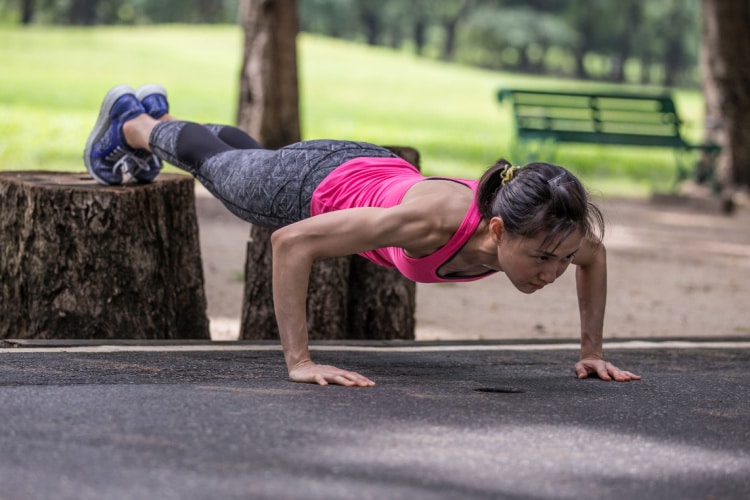
Media type: GIF
Media Content: Someone doing a decline push-up
Movement Category: Primary
Programming: 6 to 12 reps per set at 2 to 3 reps short of failure, e.g. RPE 7 to 8.
Weight: Bodyweight
An adjustment from the basic push-up, decline push-ups are for those ready for something more challenging, as the exercise is performed with your feet positioned on an elevated surface. The focus is on the upper pectoral muscles and the front shoulder area. We like them because they are a good way to increase the challenge of this exercise for people who already feel comfortable with the classic push-up.
Decline push-up instructions:
- Kneel down with your back towards a higher solid surface, like a bench or a step.
- Place your hands on the ground at shoulder-width or a bit wider. Raise your feet on the table, bench, sofa, step, or any other higher surface.
- Engage your quads, core, and glutes.
- Lower your chest as near to the ground as possible without touching it. Stop when your elbows are around your ribcage. As you’re lowering down, look straight ahead and keep your back and neck straight.
- Push yourself off the ground to return to the starting position, and then repeat.
If you feel any pain in your shoulders, elbows, or wrists, stop with the exercise.
Pro tip:
Keep in mind that the higher your chosen surface is, the tougher the exercise. If you’re a beginner, stick to lower surfaces; if you’re more advanced, feel free to raise the height after a while.
3) Incline Push-ups
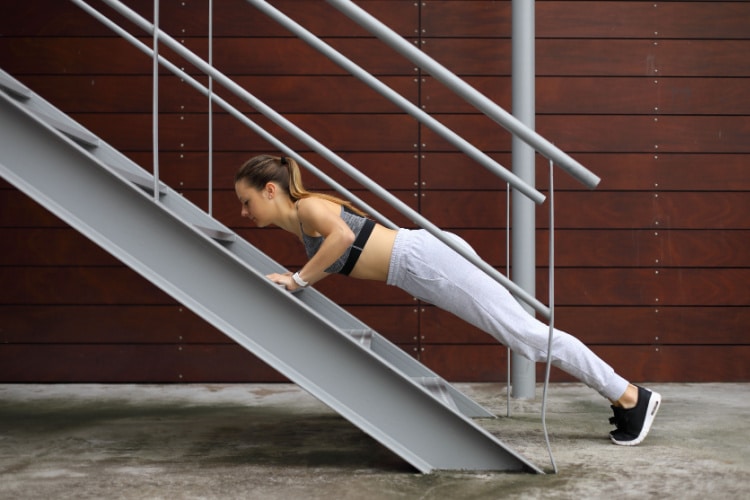
Media type: GIF
Media Content: Someone doing an incline push-up
Movement Category: Primary or Secondary
Programming: 6 to 12 (primary) or 10 to 20 (secondary) reps per set at 2 to 3 reps short of failure, e.g. RPE 7 to 8.
Weight: Bodyweight
Incline push-ups are performed with your hands on an elevated surface such as a bench or a countertop. If the standard push-up is challenging for you, or you’d like to explore a higher rep range, incline push-ups are a great alternative.
Incline push-up instructions:
- Stand in front of the elevated surface like a bench or a step and stoop over by placing both hands on the surface. Make sure your fingers point forward. Keep your hands shoulder-width apart.
- Get into a plank position, one leg at a time. Keep your body straight and your head in alignment with your spine. Make sure that your lower back isn’t sinking and that your butt isn’t sticking out.
- Flex your arms and gradually lower your chest toward the elevated surface, keeping your elbows tucked in. Extend your arms to get back into the starting position.
Pro tip:
Many make the mistake of positioning themselves very close to the elevated surface, which could cause your back to arch.
4) Offset Push-Ups
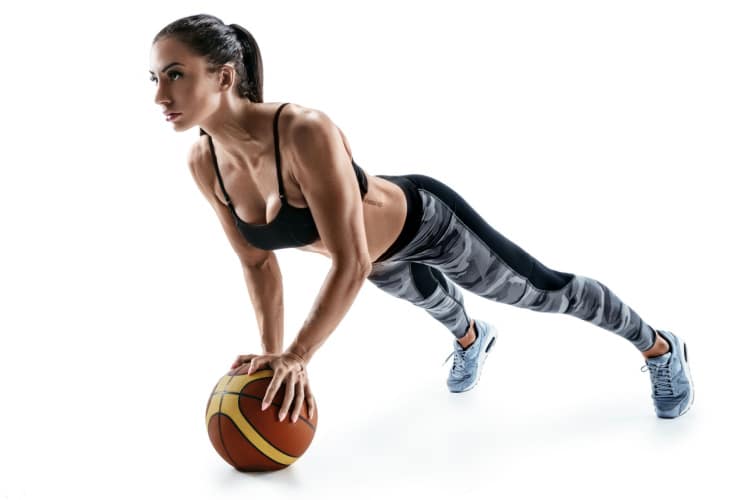
Media type: GIF
Media Content: Someone doing an off-set push-up
Movement Category: Primary
Programming: 3 to 8 reps per set at 2 to 3 reps short of failure, e.g. RPE 7 to 8.
Weight: Bodyweight
Because they work one arm at a time, offset push-ups require more core control. Plus, they’re more challenging than a standard push-up since the elevated arm is at a mechanical disadvantage relative to the arm on the floor. This exercise is part of the progression towards a one-armed push-up. Similarly, it requires more force production out of the triceps, anterior deltoid, and pec muscles in the side that’s on the floor.
Offset push-up instructions:
- Begin in the standard push-up position on the floor, but lift one hand and place it on a higher, stable surface such as an exercise bench. Your other hand should be right underneath the shoulder and your feet should be about hip-width apart.
- Gradually lower yourself down to perform the exercise and then push up to return to a one-handed plank.
Pro tip:
Make sure you complete an even number of sets as you change your arms. Additional push-up variations, if you’re looking for something more challenging as you progress towards a one-arm push-up, include:
- Half one-arm push-ups: a one-arm push-up done with a medicine ball under the hip;
- Incline one-arm push-ups: a one-arm push-up where the non-working arm is on an elevated platform.
- Archer push-ups with a medicine ball: a one-arm push-up done with the non-working arm up holding onto a medicine ball as a movable kickstand.
5) One-Leg Push-ups
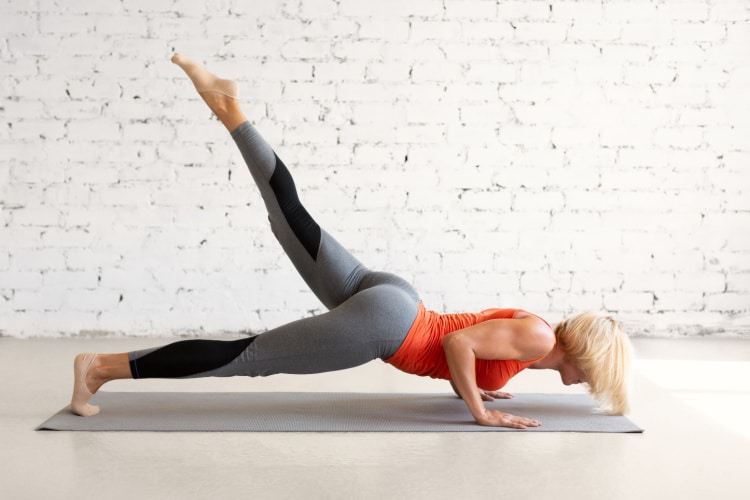
Media type: GIF
Media Content: Someone doing a one-leg push-up
Movement Category: Primary
Programming: 4 to 10 per set at 2 to 3 reps short of failure, e.g. RPE 7 to 8.
Weight: Bodyweight
By targeting “push muscles” such as the chest, shoulders, triceps, hips, and glutes and because of the fact the balance is slightly off, the one-leg push-up challenges people to work on their shoulder and core stability.
One-leg push-up instructions:
- Begin in a plank position and raise one leg off the ground. Tighten your glutes and keep your hands under your shoulders.
- Except for the raised leg, the other mechanics of the push-up remain the same — your legs should be straight, your elbows extended, and your head should be in a neutral position, with your eyes on the floor.
- Retract the shoulder blades and unlock the elbows, then slowly lower yourself towards the floor. Once you go as low as you can without losing your balance, you can get back to your starting position by straightening your elbows and pressing your hands into the ground with force.
- Repeat the exercise, alternating between legs.
Pro tip:
Keep your spine straight during the entirety of the exercise and make sure you complete an even number of reps for each leg
6) Diamond Push-ups
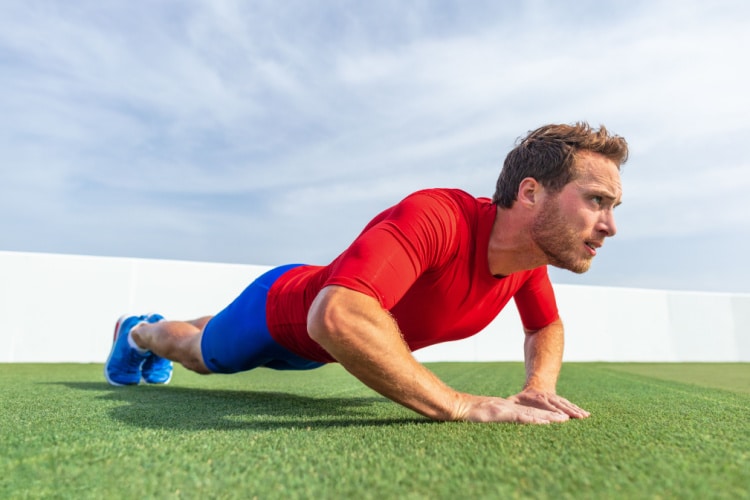
Media type: GIF
Media Content: Someone doing a diamond push-up
Movement Category: Secondary
Programming: 10 to 20 (secondary) reps per set at 2 to 3 reps short of failure, e.g. RPE 7 to 8.
Weight: Bodyweight
Diamond push-ups, also referred to as triangle push-ups, are a compound exercise best-suited for stronger trainees. As the starting position requires the person to take a much narrower hand position, forming a triangle shape with their thumbs and index fingers, this variation requires the triceps and anterior deltoid to contribute more to the movement compared to the standard push-up.
Diamond push-up instructions:
- Get on the ground (or your mat) and into a plank position.
- Unlike in a traditional push-up, your palms should form a diamond shape below your chest. Basically, connect your forefingers and thumbs.
- Lower yourself towards the ground and then push up. Ensure your back is straight at all times. Your fingers should remain in the same diamond position throughout the exercise.
Pro tip:
Keep your elbows tucked to the sides through shoulder adduction – moving the arms towards the middle of the body.
7) Plyometric push-ups
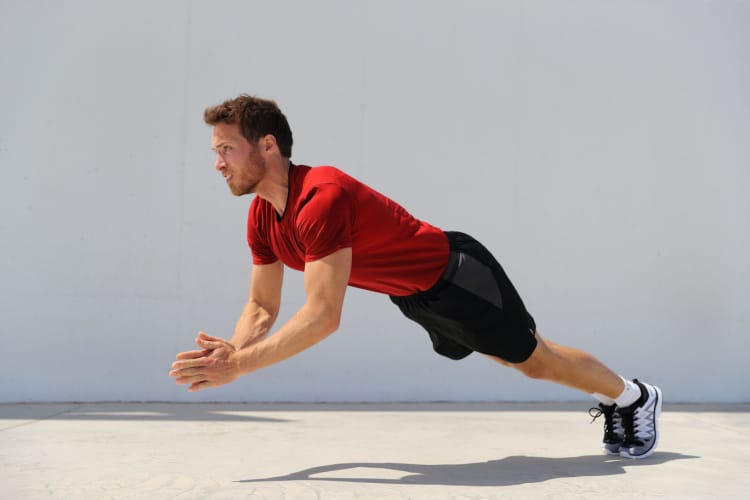
Media type: GIF
Media Content: Someone doing a plyometric push-up
Movement Category: Primary
Programming: 3 to 6 reps at 2 to 3 reps short of failure, e.g. RPE 7 to 8.
Weight: Bodyweight
While the same muscles are at play, the inherent difference between standard push-ups and plyometric push-ups is that the latter require a higher velocity force production to get your hands off the floor. In short, the muscles have to produce more force per rep in order to generate enough acceleration and subsequent velocity to leave the floor.
In essence, the biggest difference between regular push-ups and plyometric push-ups lies in the way the muscles are trained — you end up training with more speed and force. [3]
In fact, plenty of athletes choose plyometric push-ups as an efficient way of boosting their athletic performance as they increase endurance, speed, and strength.
Plyometric push-up instructions:
- Begin in a high plank. Keep your torso straight, core tight, and your hands right below your shoulders.
- Lower your body as though you’ll do a push-up until your chest almost touches the ground.
- As you push upward, do so with enough energy (explosively) to lift your hands from the floor and then repeat.
Pro tip:
To make the exercise more challenging, you could aim to push yourself higher off the floor or add a clap.
8) Wide Push-ups
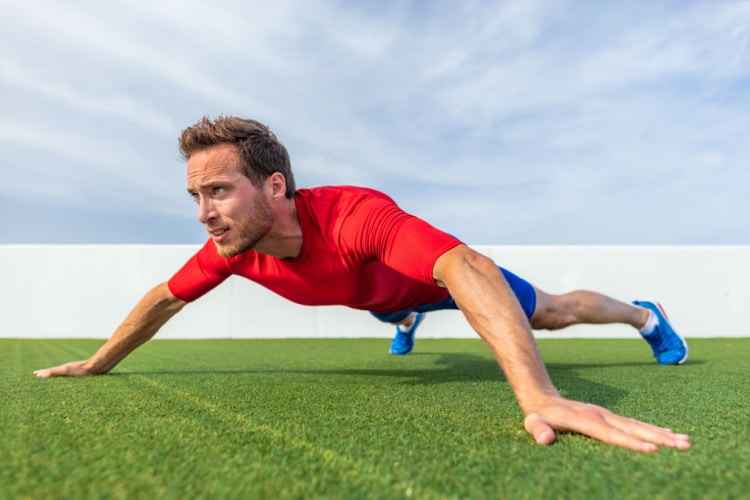
Media type: GIF
Media Content: Someone doing a wide push-up
Movement Category: Secondary
Programming: 10 to 20 (secondary) reps per set at 2 to 3 reps short of failure, e.g. RPE 7 to 8.
Weight: Bodyweight
While in standard push-ups the hands are shoulder-width apart, wide push-ups place the hands another hand-width or two wider than the shoulders.
Wide push-ups are a useful core stability exercise. Besides improving your pectoralis chest muscles, shoulders, and triceps, wide push-ups may rely on the serratus anterior muscle more than push-ups done with a narrower grip. [4] The serratus anterior spans throughout your upper rib area and assists in arm and scapula (scapular protraction) movements.
Wide push-up instructions:
- Begin in a plank position with your hands placed one-to-two hands’ width wider than your shoulders. Your fingers should be facing forward. Ensure that your spine, hips, and shoulders are straight.
- As you drop your body toward the ground, gradually bend your elbows to the side.
- When your elbows are almost underneath your chest, stop.
- As you elevate your body back to the starting position, contract your core while applying pressure with your hands.
Pro tip:
Make sure your hips aren’t sagging or moving upward, and keep your glutes and core engaged. While the overall movement is similar to a standard push-up, the wide push-up will have the elbows flare out more comparatively, as the wider grip necessitates this.
9) Seal Push-Ups

Media type: GIF
Media Content: Someone doing a seal push-up
Movement Category: Secondary or Tertiary
Programming: 10 to 20 (secondary) or 15 to 25 (tertiary) reps per set at 2 to 3 reps short of failure, e.g. RPE 7 to 8.
Weight: Bodyweight
A seal push-up is an easier variation of a standard push-up, working the same muscles but to a lesser degree. As the legs and pelvis are anchored to the floor, a smaller percentage of the individual’s body weight is being lifted. In turn, the trunk is less activated and the biceps and lats are not targeted to any significant degree – certainly not more than in a regular push-up.
Consequently, a seal push-up is an excellent alternative for those who find the standard push-up challenging and/or those aiming for a higher rep range. Most trainees can do a lot more seal push-ups than standard or incline push-ups!
Seal push-up instructions:
- Lie on your stomach with both legs stretched behind you. Your hands should be just below your shoulders.
- Tighten your glutes and push up through your arms and the top of your feet to move your torso upward and lift your knees off the ground.
- Hold the pose briefly, then, bend your elbows, and lower your torso so that it hovers just off the ground.
- Push yourself back up and begin the set rep letting only your hands and toes touch the floor when you’re in the low position.
Pro tip:
You can turn any challenging push-up variation into a seal push-up to increase the number of reps. For instance – you can’t do many diamond or wide-grip push-ups? Add the anchorage of seal push-ups and try again.
10) Deficit Push-ups
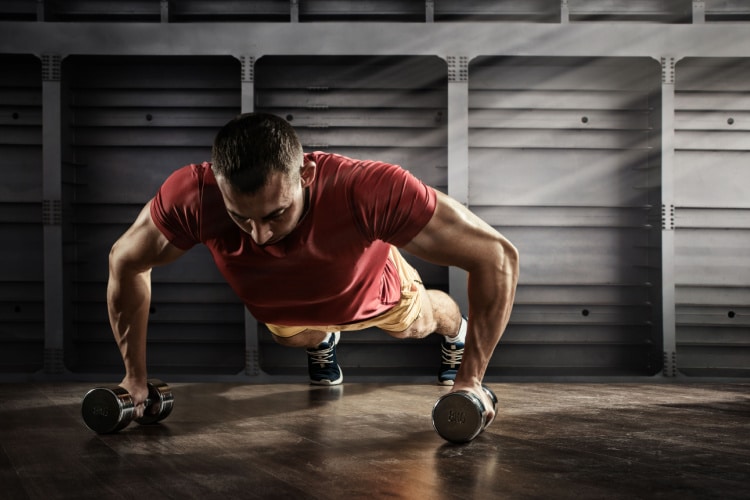
Media type: GIF
Media Content: Someone doing a deficit push-up
Movement Category: Primary or Secondary
Programming: 5 to 8 reps (primary) or 8 to 12 (secondary) reps per set at 2 to 3 reps short of failure, e.g. RPE 7 to 8.
Weight: Bodyweight
Perfect for an increased challenge and range of motion, the deficit push-ups are a compound exercise that works several joints and muscles, such as the pectoralis major, pectoralis minor, triceps brachii, serratus anterior, anterior deltoids, core, and quadriceps.
What’s more, deficit push-ups are better for hypertrophy thanks to the increased range of motion at the shoulders and elbows. This exercise allows you to hit all three key components for muscular hypertrophy: motor unit recruitment, range of motion, and volume of exercise.
Deficit Push-ups Instructions
- Create additional room between you and the ground. It’s best to place both hands on an elevated surface such as a yoga block, a weight plate, or dumbbells. The whole idea is to get that extra elevation so that you’re provided with a deeper stretch.
- Put both hands on your chosen surface wider than shoulder-width apart. Keep your abs and glutes activated.
- Squeeze your shoulder blades towards one another and maintain a tight core. Descend as you would during a regular push-up. If you’re up for a bigger challenge and more benefits, descend below the blocks – to about an inch off the ground, or as low as your body will go.
- Take a break for a second and push yourself back up while keeping your shoulder blades squeezed and your mid-back muscles relaxed throughout the entire exercise.
Pro Tip:
Be on the lookout for potential shoulder tear. If you feel too much stress in your shoulders, avoid descending too low. Don’t force your chest onto the ground right away, but increase your range of motion slowly, instead.
What Chest Muscles Do Push-Ups Improve?
Although primarily targeting the upper chest muscles, push-ups also target many other muscles in your body, which is one of the main reasons they’re so popular.
1) Pectoralis major
The pectoralis major is the largest chest muscle. In men, it’s found right below the skin and subcutaneous fat; in women, beneath the breast tissue.
Media type: Image
Media Content: The pectoralis major muscles of a human.
The pectoralis major is made of two heads, the clavicular head, which emerges from the clavicle, and the larger sternocostal head, which emerges from the sternum, the upper costal cartilages in the ribs, and finally, the tendon of the external oblique muscle. [5] This muscle assists in moving the arms and stabilizing the shoulder joint.
2) Pectoralis minor
The pectoralis minor is located right under the pectoralis major. This triangular muscle’s main job is to move and stabilize the scapulae, that is, the shoulder blades.
When doing a push-up, this muscle stabilizes your shoulder blades, allowing them to work together with the upper back to achieve the best form.
3) Triceps
The triceps are a large muscle on the back of the upper arm. Similarly to the pectoralis major, the triceps is made up of multiple parts, known as the medial, lateral, and long heads.
Media type: Image
Media Content: The tricep muscles of a human.
The primary role of the triceps is to stabilize the shoulder joint and extend the elbows. What’s more, the long head assists with adducting the humerus, like when you move the upper arm closer to your body.
During the descent, when the chest almost reaches the ground, the triceps keep the torso in check, lengthening on the way down. Then, during the ascent – when you extend your elbows – the triceps are the prime movers, producing force on your way up.
4) Anterior deltoids
The deltoids are the large muscles found on top of your shoulder joints. Like the triceps, they have three separate heads: the anterior, the lateral, and the posterior. Although all three are activated in a push-up, the anterior head sees the most recruitment thanks to its location.
When you’re in the top stage of the exercise, the anterior deltoids assist with adducting the shoulder joint; during the lower stage, they stabilize your shoulders.
5) Core muscles
Although not directly targeted by push-ups, the core muscles do feel its impact, as they help maintain posture throughout the movement so that the force produced by the upper body moves the entire body uniformly. The abdominals, entailing five major muscles — the rectus abdominis, transversus abdominis, internal and external obliques, and pyramidalis — take on most of the load, but the core (or trunk) muscles assist in maintaining a rigid torso.
Benefits of Push-Ups
Whether you’re looking to improve your muscle mass or boost your overall cardiovascular health, push-ups (and their variations) should be a part of your exercise routine.
1) Targeting Several Muscle Groups
Many people believe push-ups help improve the chest, and chest only. However, as we already saw, these exercises help engage several muscle groups at the same time, which makes them a compound exercise that actually gives you a whole-body workout:
- Chest (pectorals)
- Shoulders (deltoid major and minor)
- Arms (triceps and biceps)
- Stomach (abdominals)
To illustrate, there’s a 2020 study on shoulder electromyography (EMG) activity, which measured muscular excitation during push-up variations and showed that the pectoralis major and triceps both had high levels of excitation during unstable push-ups. [6] Also, the serratus anterior muscle showed the highest electromyography amplitude during push-up plus and incline push-ups.
2) Better Heart Health
The benefits of lifting weights for the heart include enhanced function thanks to increased muscle mass, strength, and decreased fat mass. For instance, resistance training plus aerobic exercise improves strength, work capacity, and maximal oxygen consumption (VO2 max) for individuals with stable coronary artery disease. It also reduces body fat without increasing adverse events. [7,8,9]
Additionally, resistance training improves blood pressure and lowers cholesterol levels, therefore reducing the chances of cardiovascular disease. [10, 11]
Lifting weights can also strengthen the chest muscles, another benefit for enhanced cardiac health. In summary, lifting weights has many advantages beyond simply making you stronger.
3) Improved Bone Density
Resistance training can help with osteoarthritis, a common disabling condition linked with joint pain. It usually impacts the knees, hips, and hands of middle-aged and older individuals.
Strength training produces clinically noticeable improvements in muscle strength, functional ability, and pain scores, even in patients with advanced disease. [12] What’s more, starting to lift earlier in life not only reduces loss of strength linked with osteoarthritis, but also slows down or even stops further progression of the disease. [13]
4) Improved Strength
A common question surrounding push-ups is how much weight is an individual actually lifting? When tested, a regular push-up requires an individual to lift ~64% of their body weight, whereas a kneeling push-up uses ~49%. [14] Additionally, we do have other data showing that push-ups can drive increases in chest muscle size and strength to similar levels as the bench press. [2]
5) Convenience
Push-ups are very practical exercises that you can perform without any equipment or needing to go to the gym — they can be done from the comfort of your home and on your own time.
6) Versatility
Push-ups can be as simple or as demanding as you want them to be. If you’re a beginner, you can stick with the regular or incline push-ups and make some adjustments over time as you boost your strength. If you’re looking for something more challenging, consider doing some of the more advanced push-up variations we shared with you today, such as the deficit push-ups.
Keep in mind that changing the range of motion, the angle the exercise is performed, and/or the percentage of the body being lifted (e.g. 1 arm vs 2-arm) can change how the muscles are trained. For instance, by bringing the hands closer together in a push-up, you’re requiring the triceps to contribute relatively more force to the movement. On the other hand, if you place your hands further apart, you’ll require more force production by the pectoralis major and serratus anterior.
For a more impactful workout and to make sure you continue to challenge your body over time, you can gradually increase the number of reps as you build your strength and stamina.
That’s a Wrap!
In a nutshell, push-ups and their varieties are ideal when you want to work out your chest but don’t have any fancy equipment lying around.
And if you want more, join us! At Barbell Medicine, we have a team of licensed professionals – including trainers and doctors – who can help you plan out the perfect program to achieve your personal fitness goals. We take pride in looking for measurable results and approaching fitness from a purely scientific and medical perspective, and we always keep up-to-date with the latest developments in sports science.
And – we can help you on your fitness journey in several ways!
For starters, we offer programs suitable for any fitness goal. For instance, if you’re new to resistance training or returning from some time off, consider our Beginner Template. On the other hand, if you’re an experienced barbell lifter, you’d enjoy our Hypertrophy II Template.
Beyond programs, we offer professional coaching and supplements to help you along every step of your journey to more strength, better health, and a shapelier physique.
If this sounds exciting, but you aren’t sure whether you can commit just yet, you can always subscribe to our email list and take advantage of our introductory training programs before you make a decision.
We’d love to have you join the Barbell Medicine community!
References:
1. Kikuchi, Naoki, and Koichi Nakazato. “Low-load bench press and push-up induce similar muscle hypertrophy and strength gain.” Journal of exercise science and fitness vol. 15,1 (2017): 37-42. doi:10.1016/j.jesf.2017.06.003
2. Kotarsky, Christopher J et al. “Effect of Progressive Calisthenic Push-up Training on Muscle Strength and Thickness.” Journal of strength and conditioning research vol. 32,3 (2018): 651-659. doi:10.1519/JSC.0000000000002345
3. Moore, L. H., Tankovich M. J., Riemann B. L., & Davies, G. J. (2012). Kinematic Analysis of Four Plyometric Push-Up Variations. International Journal of Exercise Science, 5(4), 334–343. https://www.ncbi.nlm.nih.gov/pmc/articles/PMC4738879/
4. Kim, Y.-S., Kim, D.-Y., & Ha, M.-S. (2016). Effect of the push-up exercise at different palmar width on muscle activities. Journal of Physical Therapy Science, 28(2), 446–449. https://doi.org/10.1589/jpts.28.446
5. Solari, F., & Burns, B. (2023). “Anatomy, Thorax, Pectoralis Major Major”. PubMed; StatPearls Publishing. https://pubmed.ncbi.nlm.nih.gov/30252247/
6. Kowalski, K. L., Connelly, D. M., Jakobi, J. M., & Sadi, J. (2021). “Shoulder electromyography activity during push-up variations: a scoping review.” Shoulder & Elbow, 175857322110193. https://doi.org/10.1177/17585732211019373
7. Marzolini, Susan et al. “Effect of combined aerobic and resistance training versus aerobic training alone in individuals with coronary artery disease: a meta-analysis.” European journal of preventive cardiology vol. 19,1 (2012): 81-94. doi:10.1177/1741826710393197
8. Yamamoto, Shuhei et al. “Effects of resistance training on muscle strength, exercise capacity, and mobility in middle-aged and elderly patients with coronary artery disease: A meta-analysis.” Journal of cardiology vol. 68,2 (2016): 125-34. doi:10.1016/j.jjcc.2015.09.005
9. Daub, W D et al. “Strength training early after myocardial infarction.” Journal of cardiopulmonary rehabilitation vol. 16,2 (1996): 100-8. doi:10.1097/00008483-199603000-00004
10. Kadoglou, Nikolaos P E et al. “The effects of resistance training on ApoB/ApoA-I ratio, Lp(a) and inflammatory markers in patients with type 2 diabetes.” Endocrine vol. 42,3 (2012): 561-9. doi:10.1007/s12020-012-9650-y
11. Naci, Huseyin et al. “How does exercise treatment compare with antihypertensive medications? A network meta-analysis of 391 randomised controlled trials assessing exercise and medication effects on systolic blood pressure.” British journal of sports medicine vol. 53,14 (2019): 859-869. doi:10.1136/bjsports-2018-099921
12. Turner MN, Hernandez DO, Cade W, Emerson CP, Reynolds JM, Best TM. The Role of Resistance Training Dosing on Pain and Physical Function in Individuals With Knee Osteoarthritis: A Systematic Review. Sports Health. 2020 Mar/Apr;12(2):200-206. doi: 10.1177/1941738119887183. Epub 2019 Dec 18. PMID: 31850826; PMCID: PMC7040944.
13. Kristensen J, Franklyn-Miller A. Resistance training in musculoskeletal rehabilitation: a systematic review. Br J Sports Med. 2012 Aug;46(10):719-26. doi: 10.1136/bjsm.2010.079376. Epub 2011 Jul 26. PMID: 21791457.
14. Suprak, David N et al. “The effect of position on the percentage of body mass supported during traditional and modified push-up variants.” Journal of strength and conditioning research vol. 25,2 (2011): 497-503. doi:10.1519/JSC.0b013e3181bde2cf